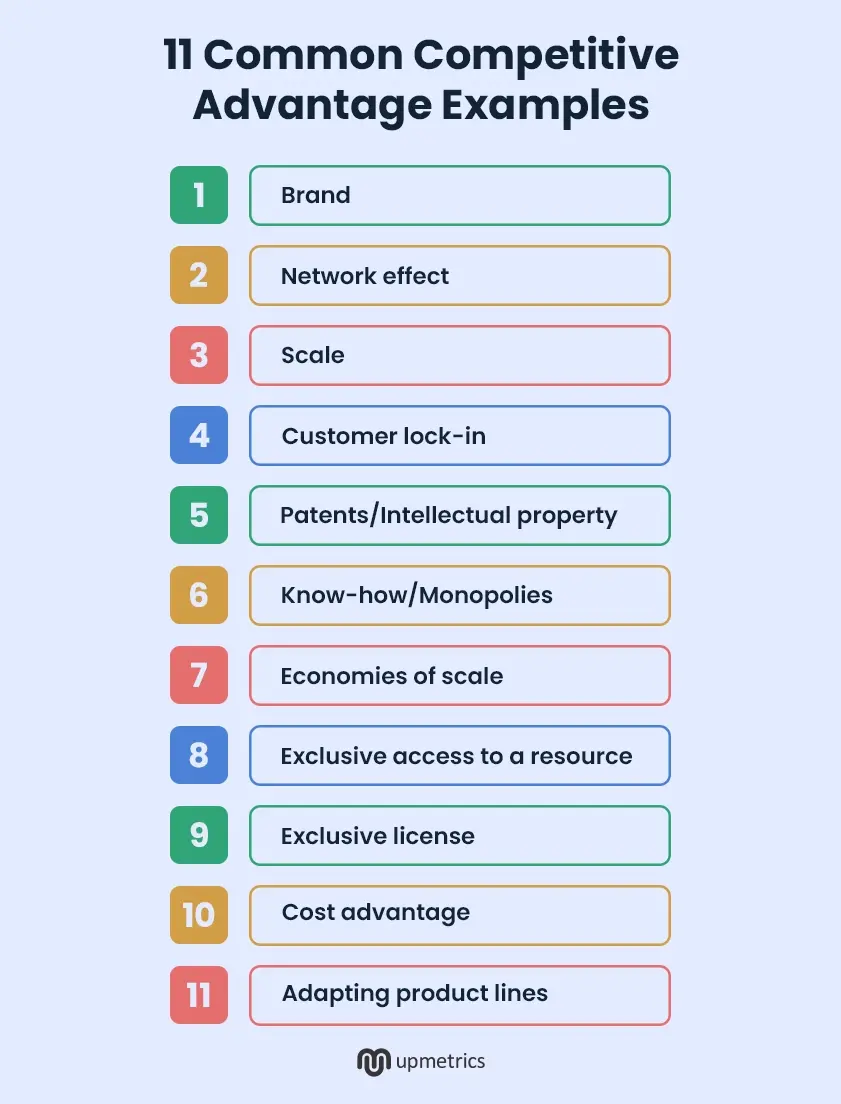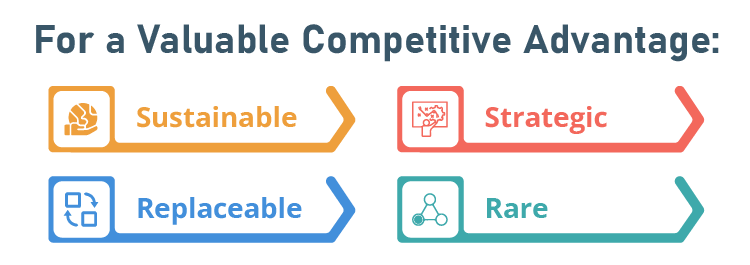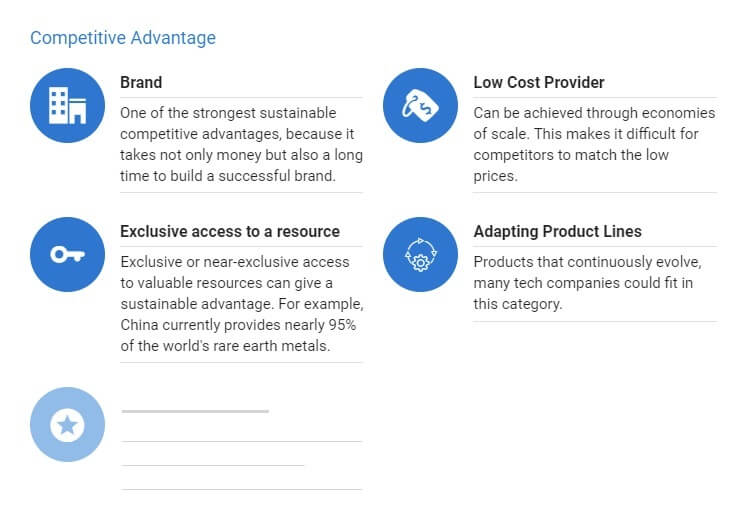In a world where competition is high and innovation is at its peak, you need something that makes you different from others in your industry. Why else would people want your products or services?
This is where competitive advantage comes in. It encompasses the strengths and opportunities that you have over your competition. It’s also the factor that helps you see which of your target audiences may decide to go with your product/service over your competitors.
Depending on your industry, there can be many other advantages. However, eventually, it’s the factor that earns you more sales and gives you a surplus in profit.
So before you start wondering what competitive advantages there can be for you, we’ll cover them all. We’ll also explain how to identify if a company has competitive advantage.
What is a competitive advantage?
Competitive advantages are the strengths and opportunities that you have over your competition. It’s an attribute an that allows a company to achieve superior profits compared to its rivals and generates more value for the company, customers, and shareholders.
11 common competitive advantage examples
Here are some common competitive advantage examples to help you understand it better:

1. Brand
Strong branding is one of the strongest sustainable competitive advantages. A lot goes into making a brand like building customer relationships, quality service/product, time, and money.
But when the company is identified as a brand in the market, it brings you a positional advantage. At the same time, your sales become easier and wider.
Apple is a prime example of powerful branding. Its minimalist, sleek designs and focus on innovation have helped create a loyal customer base. The brand is associated with premium quality, creativity, and a user-friendly experience, allowing it to charge higher prices than many competitors.
2. Network effect
The network effect happens when the value of a product or service depends on the number of its users.
In a positive network effect, the more people use it, the more valuable the product becomes. Once the user base reaches a critical mass, it’s tough for anyone else to achieve the same position.
For example, Mastercard benefits from a two-sided network effect. More merchants accept these cards because many people use them, and consumers use them because most merchants accept them.
3. Scale
Scale can give companies a sustainable advantage in several ways. For example, in the retail industry, large chains can use their scale to buy merchandise at low prices unavailable to their smaller competitors.
For example, Google’s global scale in search and digital advertising gives it a massive edge. By leveraging user data, it improves algorithms, attracts advertisers, and creates barriers for smaller competitors.
4. Customer lock-in
Some businesses make products or services that have very high switching costs for customers. For example, enterprise automation software such as ERP systems is so tightly integrated with critical customer functions that changing an ERP vendor is unthinkable.
5. Patents/Intellectual property
Patents are essentially a temporary monopoly, granted by the governments to stimulate risky R&D. Example: biotech and pharmaceutical companies.
A good example is Nike’s Flyknit patents. It protects its innovative shoe design, ensuring competitors can’t replicate the lightweight, durable technology. This IP gives Nike a competitive edge, solidifying its leadership in athletic footwear.
6. Know-how/Monopolies
If a critical enabling element can be kept secret, it can become a source of sustainable advantage.
For example, Zara’s know-how in supply chain management and its ability to quickly adapt to changing fashion trends have given it a competitive edge in the fashion industry.
7. Economies of scale
The basic tenet of economies of scale is that the cost per unit declines as output increases. The lower cost per unit is largely driven by the presence of fixed costs within the business’s cost curve.
The expert would be Walmart. They leverage bulk purchasing power to secure lower prices, passing savings to customers. Its vast distribution network boosts efficiency and reduces costs. Combined, these factors make it hard for smaller retailers to match Walmart’s low prices.
8. Exclusive access to a resource
Exclusive or near-exclusive access to valuable resources can give a sustainable advantage. For example, China currently provides nearly 95% of the world’s rare earth metals. As a result, it gains significant leverage in global supply chains for electronics, electric vehicles, and renewable energy.
9. Exclusive license
Sometimes governments grant exclusive licenses to businesses. For example, Stepan is the only company in the US that’s legally allowed to import coca leaves and extract cocaine from them.
10. Cost advantage
Cost advantage can be achieved through economies of scale. This makes it difficult for competitors to match the low prices.
For example, McDonald’s achieves cost advantage through standardized processes, bulk purchasing of ingredients, and a franchise model that reduces overhead.
11. Adapting product lines
This is for products that continuously evolve.
Netflix’s content adaptation is a brilliant example explaining adapting product lines. It evolved from a DVD rental service to a streaming powerhouse by adapting its content to consumer preferences.

Want to Perform Competitive Analysis for your Business?
Discover your competition’s secrets effortlessly with our user-friendly and Free Competitor Analysis Generator!
How do I know if a company has a competitive advantage?
During competitive analysis, you must have come across a few factors where you stand out from your competitors. If these unique factors bring you any strength or opportunity, then those advantages are valuable. And only then, they can help you thrive.
For example, if you have a larger team than your competitor, then it’s a competitive advantage. But you also need to look closer and see how this is bringing you any profit.
Is this advantage helping you bring more business? Is this advantage helping you serve more customers/clientele? Is this advantage making a positive impact on your branding? If yes, then it’s bringing you value. Hence, it’s valuable.
Other than that, there are a few different perceptions to look at your competitive advantage:

Is your competitive advantage sustainable?
Sustainable competitive advantages are company assets, attributes, or abilities that are difficult to duplicate or exceed; and provide a superior or favorable long-term position over competitors.
In this case, you have an advantage that your competition can not easily catch up with. It can include having new features for your service/products, initiating new sales and marketing strategies, or introducing new technology. This advantage is simply intuitive. It’s so much like a race-Looking at the current situation, the industry knows what is the next step. But whoever implements it first has an advantage.
For example, Apple. Inc. had this advantage when they released AirPods. That step was intuitive, groundbreaking, and sustainable until their competitors had a similar product.
Is your competitive advantage replaceable?
You may have a great advantage. But you need to know if that’s replaceable. For example, people who still don’t use AirPods, still have traditional earphones that work equally well. In fact, you will find a lot of people who would prefer earphones to air pods. In that case, having air pods as an advantage is a replaceable advantage.
Similarly, you may have a large team to cater to your target market and your company. But at the same time, if your competitor can invest in heavy technology and innovation to do the same work, then they have a replaceable advantage.
Is your competitive advantage strategic?
Such an advantage is mostly seen in the R&D department, sales, and marketing as well as in operations.
Is your competitive advantage rare?
In these cases, your competition won’t have this feature in their product/service or business. A lot of times, such an advantage lies in the way you operate. It can include having unique raw materials, a unique team management system, quicker transportation, a better-developing team, and so on and so forth.
Having a rare advantage can help you become superior sooner. And usually, having a rare advantage is like having that secret ingredient in the recipe of something, that no one can get a hack of.
You can learn these different perspectives by studying your competition analysis with a detailed overview, gaining better knowledge of the market, brainstorming with your team, and being intuitive with respect to your business.
Steps to derive Competitive Advantages
Here’s how you can go about it:
- Determine the right competition
- Understand your market situation and your position in it
- Perform competitor analysis through different frameworks to identify your strengths, weaknesses, opportunities, and threats. There are five such frameworks that you can implement:
- SWOT Analysis
- Porter’s Five Forces
- Strategic Group Analysis
- Growth-Share Matrix
- Perceptual Mapping
- Figure out the points where you stand out from your competition.
- Those stand-alone points are your competitive advantages.
- Leverage!
A table for listing your competitive advantages:
| Your business name | + What you are best at | + Why |
|---|
Add Competitive Advantage to your Business Plan
Your competitive advantage section will come after you’ve explained your competition.
In the beginning, you have to explain the competitive environment. If you’re going to put it next to the section on competitive analysis, you won’t have to go into details. Because you will already have explained them.
However, if you’re to present this section only, you will have to explain your competition. Along with that, you will also have to share analytic comparisons. For this, use pie charts, graphs, metrics, and other such diagrams.
And then, finally, start explaining your competitive advantage over your competitors. Note that you have to write this section most convincingly. So, your prospects understand your dynamics well and invest in your business. Moreover, they need to know if you have a clear strategic plan to run your business successfully.

A lot of people may want to skip this section of your business plan. But in our opinion, you must never make that mistake. For it’s your chance to tell your investors the ways you stand out from your competitors in your industry.
Importance of competitive advantages
- You get a chance to highlight your business’s strengths and opportunities
- Your investors can have an idea that you have crystal clear ways to thrive in your business
- You restore your investors’ faith in you.
- You explain why your business would be their best choice to invest in.
Conclusion
Hope we were able to cover everything there is about competitive advantage so you can start your competitive analysis today.
In fact, you can use business planning tools like Upmetrics to create a business plan showcasing your competitive analysis in the best light to lure investors or partners.
So why wait, begin analyzing your competitive advantage today so get ahead of the rest!

